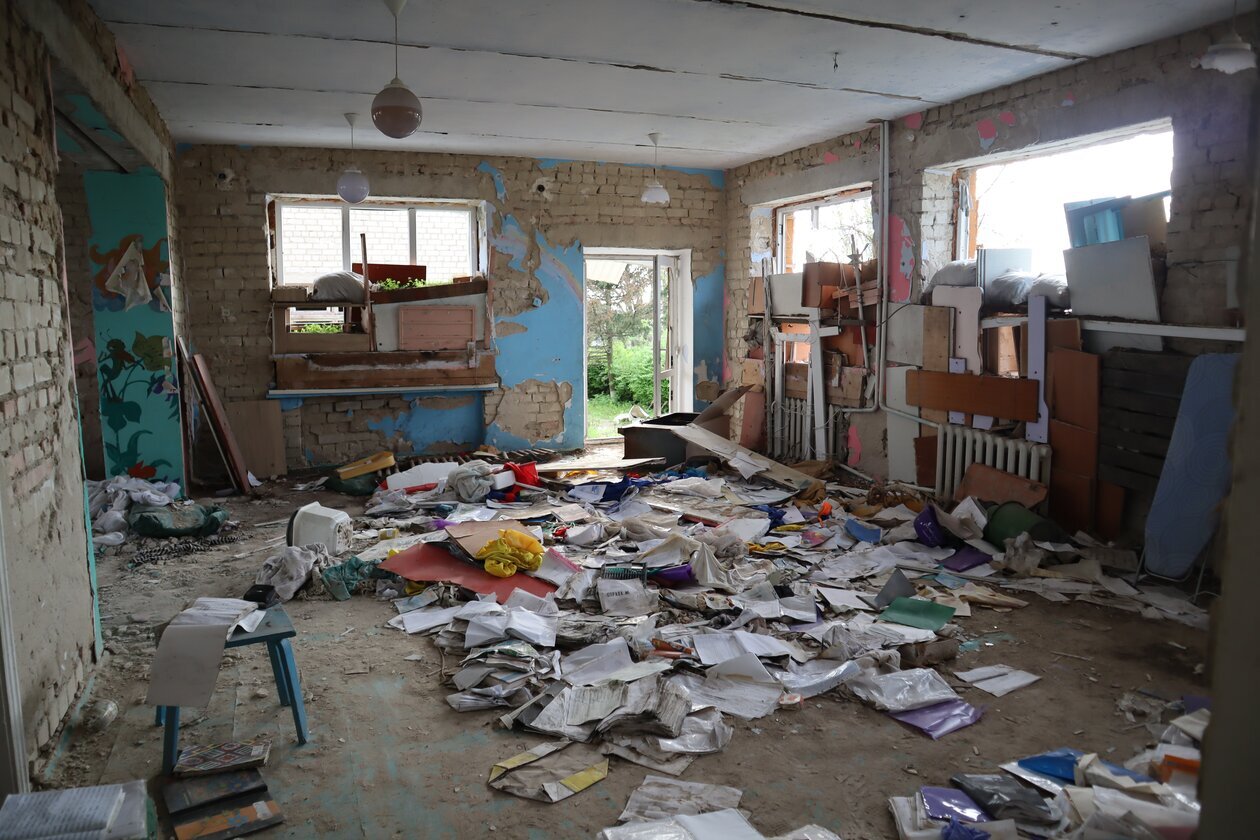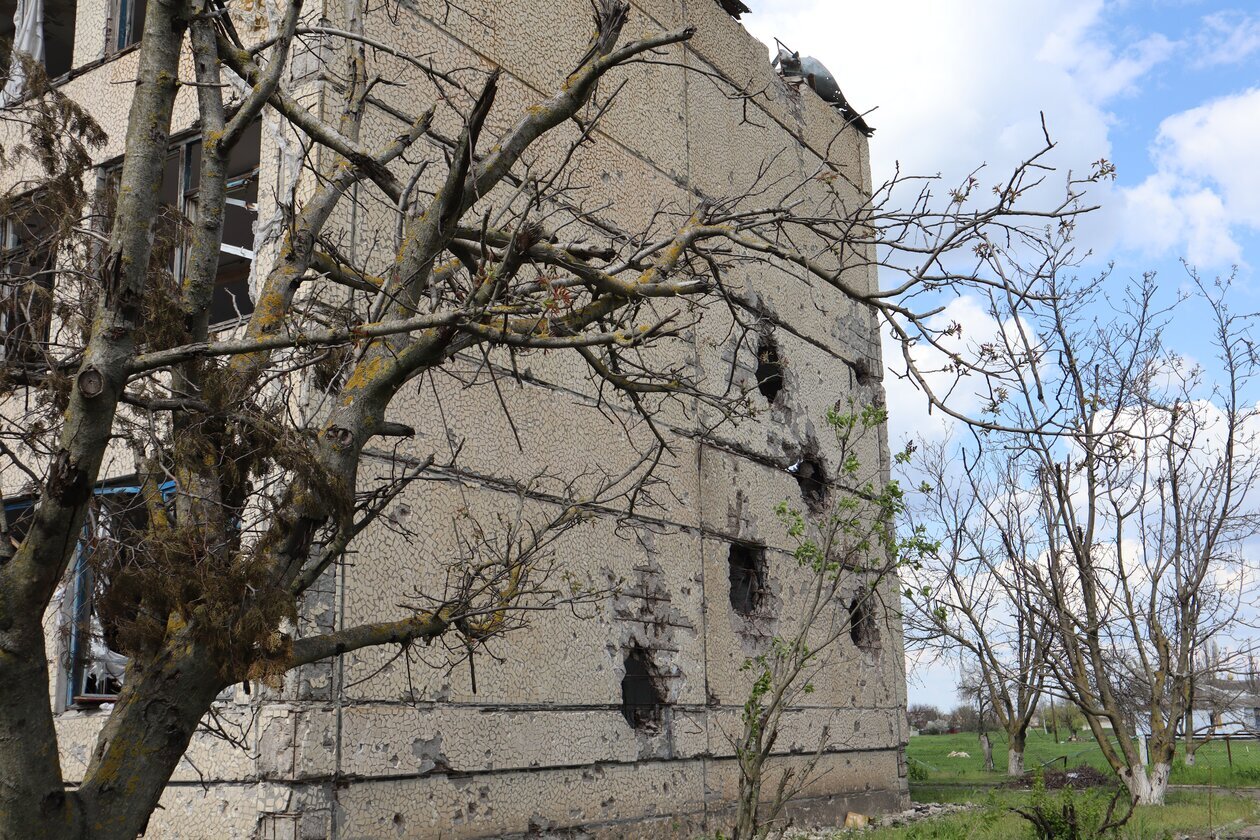Russification Strategies in Ukraine's Occupied Territories: Moscow's Approach
On the occupied territories of Ukraine, Russia imposes a sophisticated policy of Russification. It is by far not just the imposition of the Russian language, but a complex mechanism for destroying Ukrainian identity and establishing total control over the population. The Association of the Middle East Studies, a partner of the ERIC, together with the Britisch IN2 NGO, have conducted a comprehensive study of Russia's policies of Russification in Kherson and Zaporizhzhya regions. We publish this summary of the full study, with more than 30 in-depth interviews conducted with people who left the occupied territories no later than in the last 6 months, using two focus group surveys, and two social modeling games to study the vision of the processes that will take place after de-occupation.

A Russia-destroyed house in Chornobaiivka, Kherson region. Photo: Konstantyn Ovsiannikov (c)
Mechanisms of Russification
The study showed that Russification is not just the imposition of the Russian language, but a complex mechanism for destroying Ukrainian identity and establishing total control over the population of the occupied territories. Researchers have identified several key mechanisms of Russification:
1. Bureaucratic Russification - the gradual involvement of the population, households, and businesses in the Russian legal framework:
Compulsory passportization, which caused the greatest resistance;
Changing real estate documents;
Replacement of meters and other infrastructure elements;
Registration of men for military service.
2. Educational Russification - turning educational institutions into instruments of indoctrination:
Schools are mostly used not for education, but as a social instrument of control;
Most teachers are not professional educators, but random people;
Children are used as informants about the mood in families.
3. Symbolic Russification is a change in the symbolic space:
The complete removal and destruction of Ukrainian symbols;
Renaming settlements and streets;
Installation of Russian monuments, in particular, to "heroes of the Ukrainian Armed Forces";
The use of Soviet symbols and the restoration of Soviet practices.
4. Ideological Russification - the imposition of Russian values:
Creating an atmosphere of distrust and denunciation;
Imposing the concept of the "Russian world" superimposed on the Soviet matrix;
The use of Soviet practices and ideology, which for many people is associated with the return of "sovietness."
5. Violence as the main mechanism of control:
A combination of physical repression and psychological violence;
Creating a feeling of complete powerlessness among the population;
Undermining public trust, social atomization of people;
Destruction of social norms in communities.

A Russia-destroyed kindergarten in Ukrainian Stanislav, Kherson region. Photo: Konstantyn Ovsiannikov (c)
Economic methods of control
Bribery and economic manipulation:
- The initial stage of the occupation was characterized by high salaries (2.5-3 times higher than in Russia);
- This was followed by a sharp decline in wages, massive layoffs, and the introduction of high utility tariffs;
- Termination of humanitarian aid.
Collaborationism and local authorities
- The three main motives for collaboration are power, money, and coercion;
- The occupation authorities are basically appointing Ukrainian citizens to local positions to create the illusion of support from the local population.
Consequences of the occupation for the population
Psychological consequences:
- The constant emotional stirrings (hope and despair) lead to general apathy among the population;
- Atomization of society - people minimize contacts;
- Changing the time routine - the streets are empty after 15:00;
- Silence as a way of survival - people literally "have to be silent";
- Psychological traumas remain even after the release from the occupation.
It is important to understand that the apathy of the population is not a consequence of the adoption of Russian values, but the result of psychological pressure.
Challenges of de-occupation and reintegration
The second part of the study, focuses on social modeling games that allowed us to predict the processes of de-occupation and reintegration. Main conclusions:
Key challenges for de-occupation:
1. Demographic:
- The level of return to the de-occupied territories is expected to be very low;
- The population of retirement and pre-retirement age will predominate, as is already the case in the liberated territories of Kherson region.
2. Social tension:
- Distrust of those who remained under occupation;
- Risk of lynching and punitive attitudes;
- Growing distrust over time due to restrictions on communication between the occupied and free territories.
3. Economic barriers:
- Infrastructure is damaged;
- Lack of housing;
- Economic instability;
- The decline of agriculture, especially due to the disappearance of the Kakhovka reservoir.
4. Educational challenges:
- Education as a key tool for reintegration;
- Risks of conflicts between students, teachers, and parents;
- The need for distance learning and the search for new methods of communication.

A destroyed residential building in Novovorontsovka, Kherson region. Photo: Konstantyn Ovsiannikov (c)
Time perspectives and forecasts
According to the survey participants:
- De-occupation - approximately three years plus, mostly not by military means;
- Full reintegration takes about 10 years;
- Two years of distance education and the beginning of infrastructure reconstruction;
- 3-5 years - partial return of the population, implementation of peacekeeping programs;
- 6-10 years - full reintegration and achievement of stability.
Recommendations
Based on the study, the experts formulated the following recommendations:
1. Development and implementation of peacekeeping programs:
- Investing in reconciliation and dialogue programs;
- Involvement of specialists from the Ukrainian Peacekeeping School and other experts;
- Conducting trainings on negotiations and conflict resolution.
2. Balancing the "patriotic bubble":
- Avoiding excessive demands on the population of the occupied territories;
- Disseminating information about the realities of life under occupation;
- Understanding that people act primarily for survival reasons.
3. Preservation of Ukrainian identity:
- Focus on working with children and youth;
- Support for elements of Ukrainian identity;
- Socialization of displaced children.
4. Economic recovery:
- Long-term planning for socio-economic recovery;
- Creating jobs to stimulate the return of the population;
- Maintaining existing business in the frontline areas.
5. Transparent government strategy:
- Developing a clear vision of de-occupation and reintegration;
- Restoring public confidence in the government;
- Managing public expectations regarding the timing of recovery.